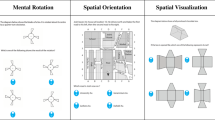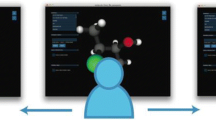Abstract
As we witness a push toward studying spatial reasoning as a principal component of mathematical competency and instruction in the twenty first century, we argue that enactivism, with its strong and explicit foci on the coupling of organism and environment, action as cognition, and sensory motor coordination provides an inclusive, expansive, apt, and fit framework. We illustrate the fit of enactivism as a theory of learning with data from an ongoing research project involving teachers and elementary-aged children’s engagement in the design and assembly of motorized robots. We offer that spatial reasoning with its considerations of physical context, the dynamics of a body moving through space, sensorimotor coordination, and cognition, appears different from other conceptual competencies in mathematics. Specifically, we argue that learner engagements with diverse types of informationally ‘dense’ visuo-spatial interfaces (e.g., blueprints, programming icons, blocks, maps), as in the research study, afford some of the necessary experiences with/in a vast number of cases described by Varela et al. (1991) that enable the development of other mathematical competencies.






Similar content being viewed by others
Notes
We use the current spelling—sensorimotor—which in our opinion also serves to signal the juxtaposition of sensory and motor coordination.
References
Barnett, T. (2013). What is spatial ability? wiseGEEK. Retrieved September 26, 2013, from http://www.wisegeek.org/what-is-spatial-ability.htm.
Begg, A. (2013). Interpreting enactivism for learning and teaching. Education Sciences and Society, 4(1). Retrieved January 15, 2014 from http://riviste.unimc.it/index.php/es_s/article/view/699.
Bergen, B. (2012). Louder than Words: The new science of how the mind makes meaning. NY: Basic Books.
Brown, L., & Coles, A. (2011). Developing expertise: how enactivism reframes mathematics teacher development. ZDM—The International Journal on Mathematics Education, 43(6–7), 861–873. doi:10.1007/s11858-011-0343-4.
Bruce, C. D., Moss, J., Sinclair, N., Whiteley, W., Okamoto, Y., McGarvey, L., et al. (2013). Early years spatial reasoning: Learning, teaching and research implications. Workshop Presented at the NCTM research presession: Linking research and practice, Denver, CO.
Carlson, A. G., Rowe, E., & Curby, T. W. (2013). Disentangling fine motor skills’ relations to academic achievement: the relative contributions of visual–spatial integration and visual–motor coordination. The Journal of Genetic Psychology, 174(5), 514–533. doi:10.1080/00221325.2012.717122.
Casey, B., Erkut, S., Ceder, I., & Young, J. (2008). Use of a storytelling context to improve girls’ and boys’ geometry skills in kindergarten. Journal of Applied Developmental Psychology, 29, 29–48.
Cummins, F. (2013). Towards an enactive account of action: speaking and joint speaking as exemplary domains. Adaptive Behavior, 21(3), 178–186. doi:10.1177/1059712313483144.
Davis, B. (1996). Teaching mathematics: toward a sound alternative. New York: Garland.
Dewey, J. (1896). The reflex arc concept in psychology. Psychological Review, 3(4), 357–466.
Di Jaegher, H., & Di Paulo, E. (2013). Enactivism is not interactionism. Frontiers in Human Neuroscience, 6(345), 1–2. doi:10.3389/fnhum.2012.00345.
Ernest, P. (2006). Reflections on theories of learning. ZDM—The International Journal on Mathematics Education, 38(1), 3–7.
Gojak, L. (2012). Helping our students become mathematical thinkers. Presidential Address presented at the NCTM 2012 Annual Meeting, Philadelphia. Retrieved February 12, 2014, from http://www.nctm.org/conferences/content.aspx?id=33201.
Grissmer, D., Grimm, K. J., Aiyer, S. M., Murrah, W. M., & Steele, J. S. (2010). Fine motor skills and early comprehension of the world: two new school readiness indicators. Developmental Psychology, 46(5), 1008–1017. doi:10.1037/a0020104.
Humphreys, G. W., Yoon, E. Y., Kumar, S., Lestou, V., Kitadono, K., Roberts, K. L., et al. (2010). The interaction of attention and action: from seeing action to acting on perception. British Journal of Psychology, 101(2), 185–206. doi:10.1348/000712609X458927.
Hutto, D. D. (2013). Psychology unified: from folk psychology to radical enactivism. Review of General Psychology, 17(2), 174–178. doi:10.1037/a0032930.
Jansen, P., Schmelter, A., Quaiser-Pohl, C., Neuberger, S., & Heil, M. (2013). Mental rotation performance in primary school age children: are there gender differences in chronometric tests? Cognitive Development, 28(1), 51–62. doi:10.1016/j.cogdev.2012.08.005.
Kahneman, D. (2011). Thinking, Fast and Slow. NY: Farrar, Strauss & Giroux.
Kayhan, E. B. (2005). Investigation of high school students’ spatial ability. Middle East Technical University, Turkey. Retrieved September 25, 2013, from https://etd.lib.metu.edu.tr/upload/12605771/index.pdf.
Keen, R., Carrico, R. L., Sylvia, M. R., & Berthier, N. E. (2003). How infants use perceptual information to guide action. Developmental Science, 6(2), 221–231. doi:10.1111/1467-7687.00274.
Lakoff, G., & Núñez, R. E. (2000). Where mathematics comes from: how the embodied mind brings mathematics into being. New York: Basic Books.
Linn, M. C., & Petersen, A. C. (1985). Emergence and characterization of sex differences in spatial ability: a meta-analysis. Child Development, 56(6), 1479–1498. doi:10.2307/1130467.
Maheux, J. F., & Proulx, J. (2015). Doing|mathematics: Analysing data with/in an enactivist-inspired approach. ZDM—The International Journal on Mathematics Education, 47(2).
Mgombelo, J., & Reid, D. A. (2015). Key concepts in enactivist theory and methodology. ZDM—The International Journal on Mathematics Education, 47(2).
Newcombe, N. S. (2010). Picture this: increasing math and science learning by improving spatial thinking. American Educator, 34(2), 29–35.
Pouw, W. T. J. L., van Gog, T., & Paas, F. (2014). An embedded and embodied cognition review of instructional manipulatives. Education Psychology Review, 26, 51–72. doi:10.1007/s10648-014-9255-5.
Presmeg, N. (2014). Contemplating visualisation as an epistemological learning tool in mathematics. ZDM—The International Journal on Mathematics Education, 46(1), 151–157. doi:10.1007/s11858-013-0561-z.
Proulx, J. (2013). Mental mathematics, emergence of strategies, and the enactivist theory of cognition. Educational Studies in Mathematics, 84(3), 309–328. doi:10.1007/s10649-013-9480-8.
Rivera, F. D., Steinbring, H., & Arcavi, A. (2014). Visualisation as an epistemological learning tool: an introduction. ZDM—The International Journal on Mathematics Education, 46(1), 1–2. doi:10.1007/s11858-013-0552-0.
Rushton, S. K. (2008). Perceptually guided action: a step in the right direction. Current Biology, 18(1), R36–R37. doi:10.1016/j.cub.2007.10.064.
Sparks, S. D. (2013). Children’s spatial skills seen as key to math learning. Education Week, 32(31). Retrieved January 8, 2014, from http://www.edweek.org/ew/articles/2013/05/15/31learning.h32.html.
Tepylo, D. (2013). Spatial reasoning: considerations for mathematics educators. Toronto: University of Toronto.
Varela, F. J. (1999). Ethical know-how: Action, wisdom, and cognition. Stanford University Press.
Varela, F. J., Thompson, E., & Rosch, E. (1991). The embodied mind: cognitive science and human experience. Cambridge: MIT Press.
Villalobos, M. (2013). Enactive cognitive science: revisionism or revolution? Adaptive Behaviour, 21(3), 159–167.
von Glasersfeld, E. (1995). Radical constructivism: a way of knowing and learning. Washington, D.C.: Falmer Press.
Acknowledgments
This research was funded by the Imperial Oil Science Engineering and Technology (IOSTEM) Education Initiative. We thank the teachers and children who participated in the IOSTEM Academy. We are also grateful to Michael Poscente for designing and coaching the Lego™ robotics task and Dr. Shalini Khan for editorial and proofreading assistance.
Author information
Authors and Affiliations
Corresponding author
Rights and permissions
About this article
Cite this article
Khan, S., Francis, K. & Davis, B. Accumulation of experience in a vast number of cases: enactivism as a fit framework for the study of spatial reasoning in mathematics education. ZDM Mathematics Education 47, 269–279 (2015). https://doi.org/10.1007/s11858-014-0623-x
Accepted:
Published:
Issue Date:
DOI: https://doi.org/10.1007/s11858-014-0623-x




